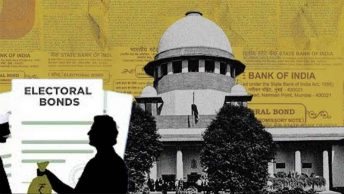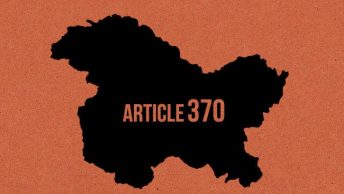Summary: This piece criticizes the Supreme Court’s decision supporting the abrogation of Article 370, arguing that it undermines federalism.
The Supreme Court (“SC”) handed down a unanimous judgment upholding the abrogation of Art. 370 and the status of Jammu and Kashmir as a union territory. This is a significant finding given that it has implications for federalism, a part of the basic structure of the Constitution.
The SC held that having irreversible consequences cannot be a ground to challenge the exercise of power by the President under Art. 356 since neither the interpretation supports this nor the rejection of enduring rights theory in Krishna Kumar can be applied to Art. 356. In Krishna Kumar, the SC rejected the enduring rights by holding that rights and obligations due to an ordinance cease to exist when an ordinance ceases to exist since it derogates from parliamentary supremacy. The SC in the present case reaffirmed this. It held that ‘enduring’ changes cannot be made before the approval by Parliament. However, since the proclamation under Art.356 was approved by the Parliament, the SC rejected the transposition of this theory to Art. 356. Regardless of this, I seek to demonstrate that Art. 356, if interpreted structurally given the nature of Indian federalism supports the claim that Proclamations under Art. 356 cannot create irreversible consequences. Art. 356 allows the President to assume the functions of the state government. Given this, if Art. 356 is examined in light of other relevant articles Art. 3 and Art. 370, and the principle of federalism, it can be seen that actions or legislations brought about under Art. 356 cannot create irreversible consequences. For this, I examine two ways in which constitutional irreversibility was brought about in the present case, first, by resorting to Art. 3 which gives supremacy to the Union, and second, by affecting the principle of federalism underlying Art. 370.
Art. 3 and the Union’s Supremacy
To justify limited judicial oversight over actions taken under Art. 356, the SC observed that the ‘political process can correct itself.’ It emphasized that when the Parliament enacts legislation on behalf of the state, the state can subsequently repeal it once the Proclamation ceases to operate. Thus, the SC held that the impact of a Proclamation under Art. 356 would have limited impact, thus, no irreversibility, since the states can approve or disapprove such decisions.
The SC seems to assume that states possess both legislative and executive authority to reverse the decision. This fails to consider scenarios, like the present case, where the quasi-federal nature of the Indian constitution grants supremacy to the Union. Since the legislation was enacted under Art. 3, considering that the states’ stance is merely recommendatory, even if the state disagrees with the legislation, it lacks the authority to reverse it. To uphold the autonomy of the states, no legislation can be enacted under the provisions which give primacy to the Union, during the subsistence of Proclamation. The quasi-federal nature substantially limits the power of the states to repeal the legislation even after the Proclamation ceases to operate.
Art. 356 and the Impact on Federalism
The scope of the effect of the Proclamation is further limited by the purpose of Art. 356 which is to restore the federal constitutional mechanism eventually. The legislative and executive action must have a proximate relationship to the object and purpose underlying the suspension of constitutional machinery. Such satisfaction of the President must be based on objective material either through the Governor’s report or ‘otherwise.’ As established by SR Bommai Case, the legitimacy of such inference is subject to judicial review but the burden on the Union to prove the presence of ‘objective material’ shifts only once the petitioner makes a prima facie case challenging the Proclamation. Applying this criterion to the present case, the action which reduced Jammu and Kashmir to the status of a Union Territory must have a ‘proximate relationship’ to restoring the functioning of the constitutional machinery. However, the SC does not delve into this analysis on the ground that the petitioners had failed to make a prima facie case that the exercise of power is mala fide or extraneous. Due to the inability of SC to examine this, the legislation under Art. 356 and its irreversible changes could not be questioned.
I argue that this position in Indian jurisprudence has failed to effectively exercise a check on Executive power. The history of (mis)use of Art. 356 shows that the standard of satisfaction required for Art. 356, that the State cannot function according to the constitutional machinery, has more often than not been politically motivated but impossible to prove. The pre-condition of proving malfeasance places an unfair and extraordinary burden on the claimant because Art. 74 (2) clearly states that any advice tendered by the Council of Ministers to the President cannot be examined by the courts. The material that the advice is based on can be inquired into by the courts because this does not become a part of the advice. The disclosure of this material is not mandatory either. The petitioner’s ability to prove mala fide exercise of power is thus, contingent upon the court’s order to the Council of Ministers to the limited disclosure of only the material. In the context of the removal of the Governor, the court has previously held that it would not interfere merely because a different view is possible or that the material or reasons are insufficient. This aggravates the standard of proving malfeasance. This fails to address the varying gravity of Executive actions. For example, the immunity granted to the advice is the same for Art. 356 (President’s rule) and Art. 123 (Ordinance power) despite the far greater consequences that a decree under the former has, especially for federalism, a part of the basic structure. Thus, the difficulty of proving even a prima facie case shows that a majority of Executive actions remain effectively immune from judicial review. I argue that the present case offered a chance to deal with this challenge, in furtherance of federalism.
The immunity of advice from judicial review is justified based on the doctrine of political thicket, i.e., such an advice is exercise of the President’s political judgment and it is “difficult to evolve judicially manageable norms for scrutinizing such political decisions.” The immunity for making the Proclamation is extended even to the actions taken under Art. 356 (1) (c) which can include suspending the operation of any constitutional provision as per the text of Art.356 (1) (c). I argue that there can be no immunity, i.e., no restriction on judicial review to such advice when the actions affect the constitution’s structural principles like federalism as in the present case. Thus, the courts have to identity whether the suspension of the provision affects such a principle. Actions affecting principles would be against the Framer’s intent of ‘restoring the functioning of constitutional machinery.’ This phrase means that the form of the Constitution must be maintained. The purpose of actions under Art. 356 is to maintain the form of the Constitution. This implies that such actions cannot deteriorate provisions (like Art. 370) based on the principles, (here federalism) considered as a part of form and basic structure of the Constitution. When the actions under Art. 356 are contrary to the very purpose of the article itself, not granting immunity to advice seems justified. Such judicial power must be carefully exercised to maintain the separation of powers. It may be argued that Art. 370 does not form a part of federalism. However, Art. 370 was envisaged to grant greater sovereignty to Jammu and Kashmir and facilitate its incorporation into the Indian Union. Since federalism necessarily deals with the distribution of sovereign powers between the Union and the states, the purpose of Art. 370 makes it an important element of federalism.
The above analysis has the following implications for the present and similar judgments involving an interplay between Art. 356 and structural principles of the constitution: First, there are constraints on the power of states in relation to legislations made under Art. 356 Proclamation. Changes affecting these provisions would be irreversible, implying that the federal structure of India necessitates a careful consideration of state powers and their limitations under such circumstances. Second, the current interpretation, which may make it difficult to establish a prima facie case for mala fide advice and judicial review, curtails the power of the judiciary. However, a structural reading of federalism suggests that barriers to judicial review could be overcome, particularly when the structural principles of federalism are affected (here, I have argued that Art. 370 is an important element of federalism). Finally, due to the limitations inherently imposed by federalism on states and the challenges in judicial review, actions taken under Art. 356 cannot result in irreversible changes. The limitations on states under Art. 356 will continue to exist due to the quasi-federal structure of India but the standard of judicial review vis-à-vis Art. 356 can be interpreted to question the immunity to advice when the constitution’s structural principles are affected. Thus, there is an opportunity for the SC to interpret Art. 356 structurally to safeguard against irreversible changes to the constitutional framework.
In essence, I posit that the interplay between federalism, judicial review, and the limitations on state powers under Art. 356 underscores the resilience of the Indian constitutional structure against irreversible changes, despite potential challenges that can circumvent federalism.







Hi,
I hope you are doing well.
I am Toni Morrison, I am a blogger and a writer.I’m reaching out because I had some ideas for your blog lawandotherthings.Audience would positively love it, and I was wondering if you’d be open to a guest blog post.Thanks for your time and consideration! I am waiting to hear back from you.Warm & Regards,Toni Morrison.